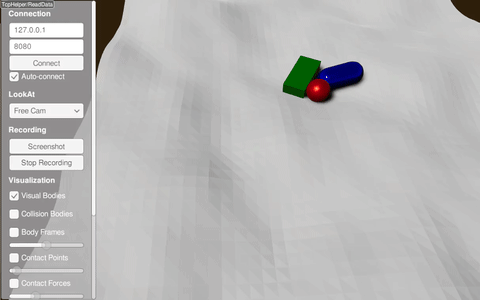Height Map Using a Text File¶

An example text file is shown below
5 5 10 10
1 1 1 1 1 1 0 0 0 1 1 0.5 0 0 1 1 0 0 0 1 1 1 1 1 1
The numbers in the first line are “xSamples”, “ySamples”, “xSize” and “ySize”, respectively. The numbers in the second line are height values.
XML Way¶
Try it yourself with
./xmlReader <PATH_TO_RAISIMLIB>/rsc/xmlScripts/heightMaps/heightMapUsingTxt.xml
The xml file is constructed as following:
<?xml version="1.0" ?>
<raisim version="1.0">
<timeStep value="0.001"/>
<objects>
<sphere name="sphere" mass="1">
<dim radius="0.5" />
<inertia xx="0.1" xy="0" xz="0" yy="0.1" yz="0" zz="0.1" />
<state pos="0 0 5" quat="1 0 0 0" linVel="0 0 0" angVel="0 0 0" />
</sphere>
<capsule name="capsule" mass="1">
<dim radius="0.5" height="1" />
<inertia xx="0.1" xy="0" xz="0" yy="0.1" yz="0" zz="0.1" />
<state pos="1 0 5" quat="1 0 0 0" linVel="0 0 0" angVel="0 0 0" />
</capsule>
<box name="box" mass="1">
<dim x="0.5" y="1" z="2"/>
<inertia xx="0.1" xy="0" xz="0" yy="0.1" yz="0" zz="0.1" />
<state pos="1 1 5" quat="1 0 0 0" linVel="0 0 0" angVel="0 0 0" />
</box>
<heightmap name="terrain" text="[THIS_DIR]/heightMapExample.txt" centerX="0" centerY="0"/>
</objects>
</raisim>
C++ Way¶
auto hm = world.addHeightMap("<PATH-TO-TEXT-FILE>/heightMapExample.txt", 0, 0);